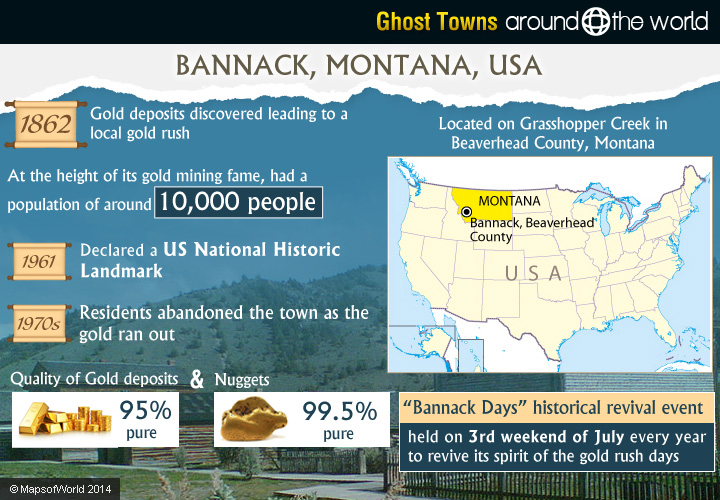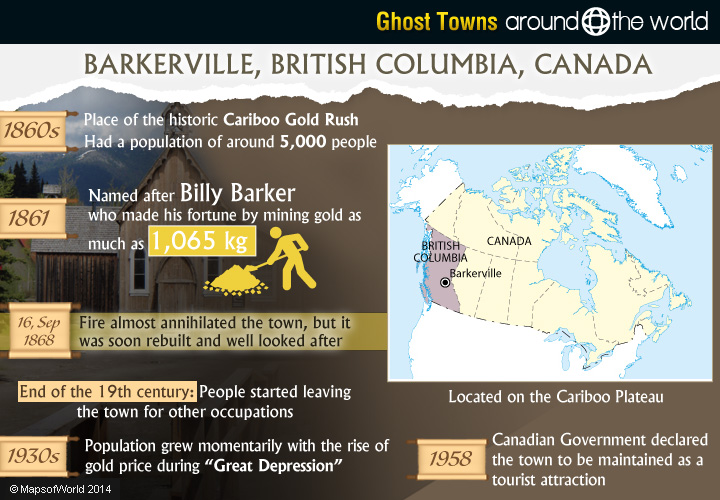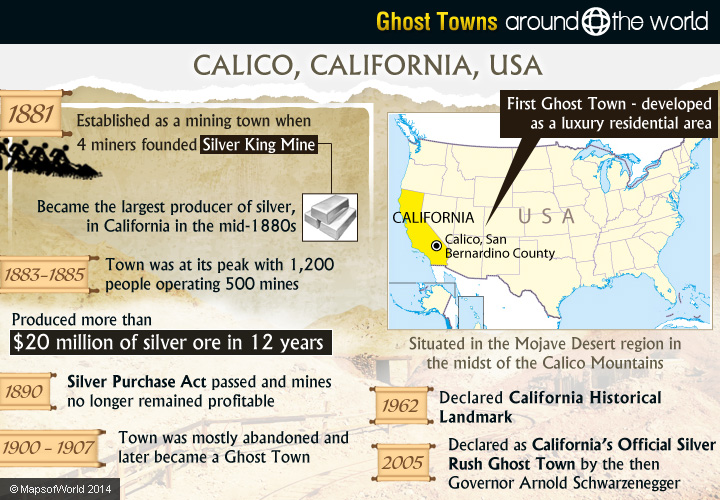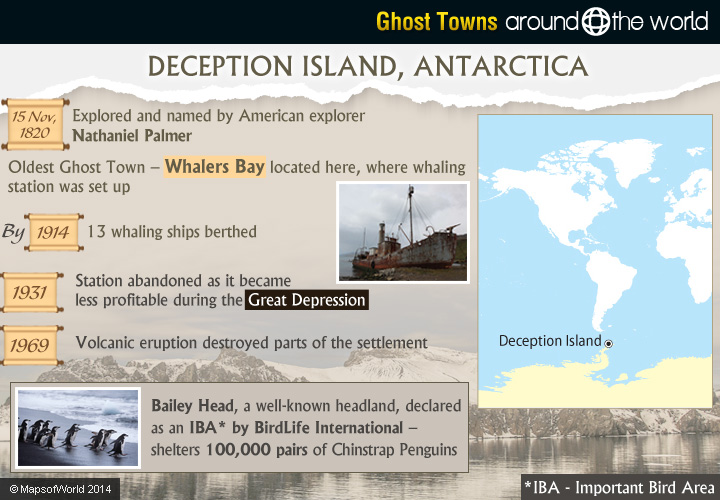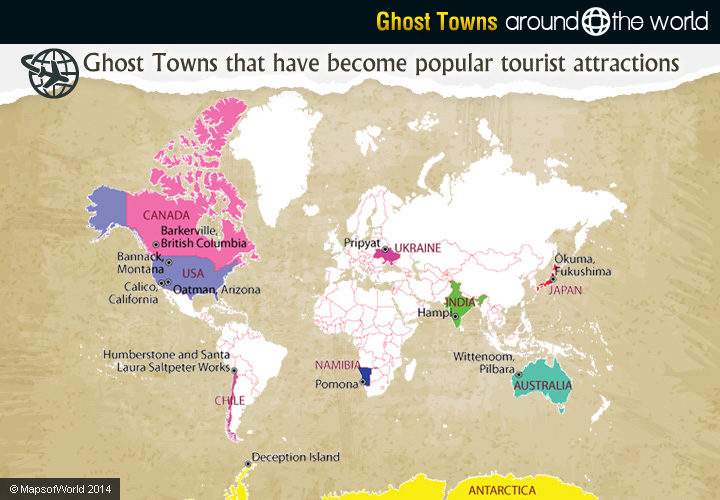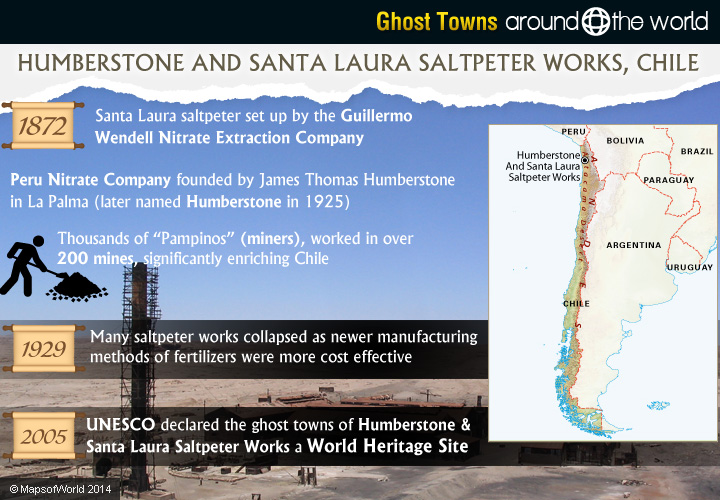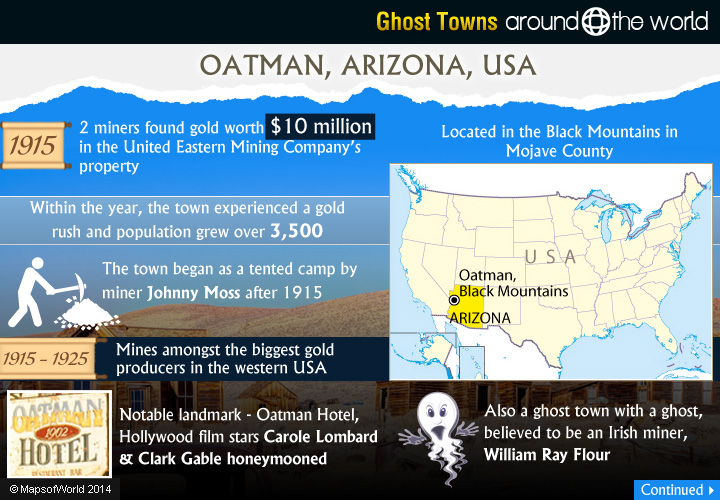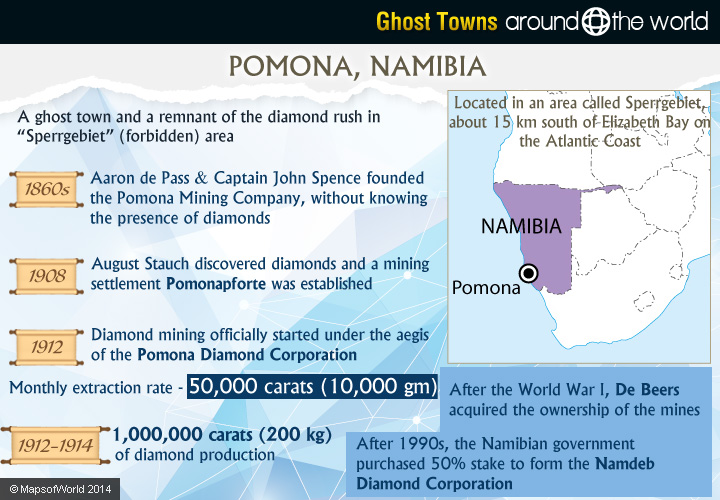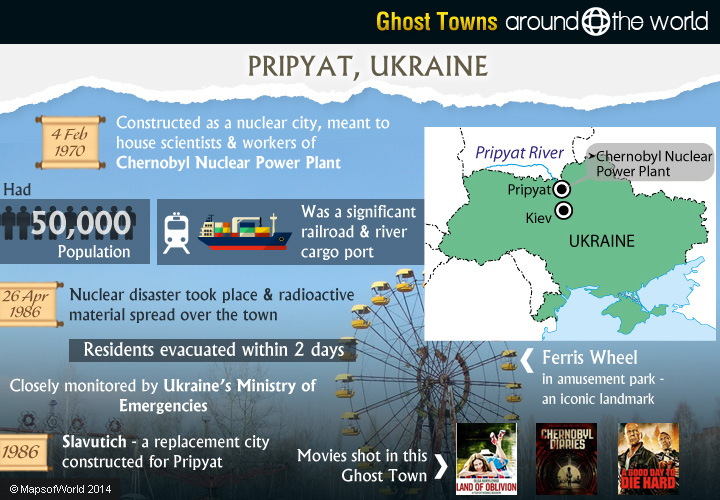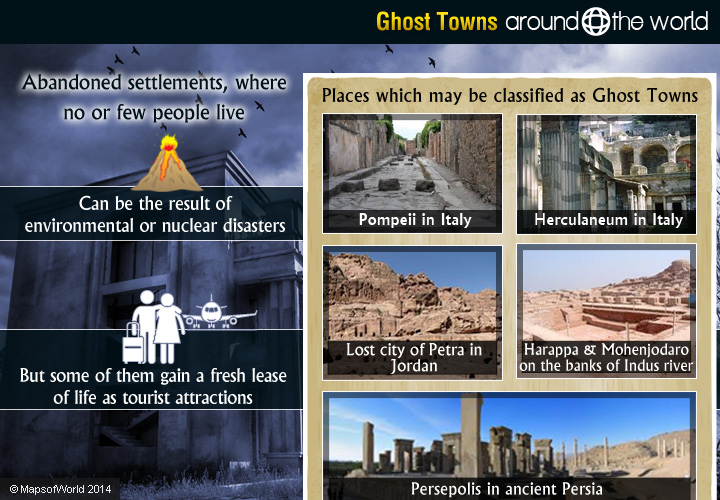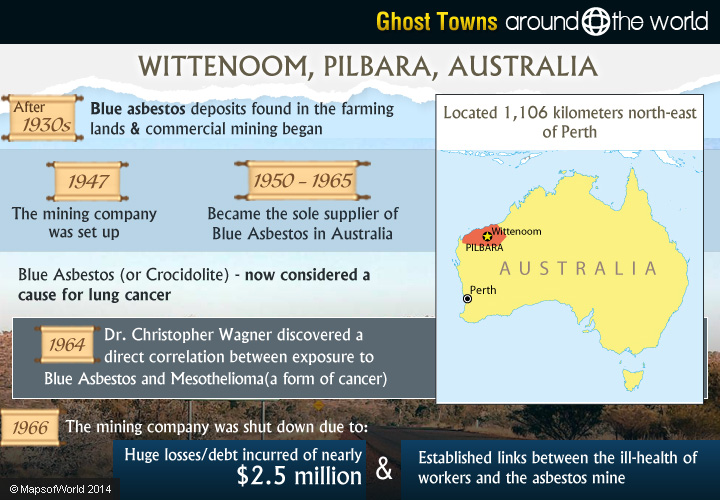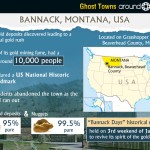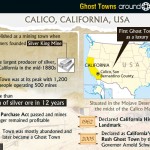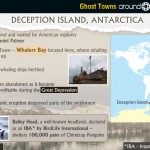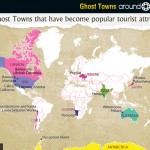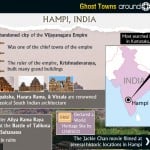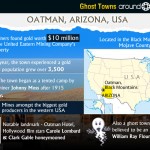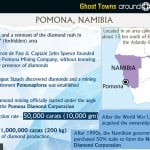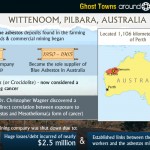Ghost Towns Around the World
Do you believe in ghosts? Well, whether ghosts exist or not, ghost towns certainly do. And no, they don’t have anything to do with ghosts! Ghost towns are abandoned settlements, where people no longer live, or very few people do. A once-busy town, often created as a result of some industry nearby such as mining, which was shut down or abandoned as the economic activity slowed down, but where buildings and other structures remain, is a ghost town. Ghost towns around the world may also come about as a result of environmental or nuclear disasters. Some old ghost towns gain a fresh lease of life as tourist attractions.
Perhaps the earliest ghost towns are Pompeii and Herculaneum, ancient cities in Italy that were destroyed in 79 AD when the volcano Mt. Vesuvius erupted burying the towns in a cloud of ash. The buildings were destroyed, but there are enough remains for historians and tourists to learn about the ancient way of life in these cities. The Lost city of Petra in Jordan, the city of Persepolis in ancient Persia and the abandoned cities of Harappa and Mohenjodaro along the banks of the river Indus, could also be considered among the earliest ghost cities. Read on to find out more about real ghost towns around the world.
Famous Ghost Towns Around the World
Ghost towns around the world have become popular tourist attractions, as travelers visit them to see an earlier way of life and seek to understand how people lived in earlier times.
Some of the well-known ghost towns around the world are:
- Bannack, Montana, USA
- Barkerville, British Columbia, Canada
- Calico, California, USA
- Deception Island, Antarctica
- Humberstone and Santa Laura Saltpeter Works, Chile
- Oatman, Arizona, USA
- Okuma, Fukushima, Japan
- Pomona, Namibia
- Pripyat, Ukraine
- Wittenoom, Pilbara, Australia
- Hampi, India
Discover more about these fascinating abandoned ghost towns around the world.
Bannack, Montana, USA
Bannack is located on Grasshopper Creek in Beaverhead County, Montana, USA. Significant deposits of gold were discovered here in 1862, leading to a local gold rush. At the height of its gold mining fame, Bannack had a population of around 10,000 people. It was also the capital of Montana Territory in 1864. The capital was later shifted to Virginia City. As the gold ran out, and people began to move away, the town shrank in size. Finally, in the 1970s, the last residents of Bannack abandoned this old west ghost town.
It is said that most of the gold deposits are 95% pure whereas nuggets, which are found along the Grasshopper Creek are said to be 99.5% pure, an exceptional quality.
The buildings in Bannack were built of logs, though some had false fronts with decorations on them. Now 60 well-maintained buildings remain in Bannack, which was declared a US National Historic Landmark in 1961. On the third weekend of July every year the “Bannack Days” historical revival event is held, where history enthusiasts revive the spirit of Bannack in its gold rush days. They re-enact the daily life of the miners and enjoy an old-time breakfast at the Meade Hotel, a historic building in this abandoned, but well-preserved ghost town.
Barkerville, British Columbia, Canada
Barkerville is located on the Cariboo Plateau in British Columbia, Canada on Highway 26 which retraces an ancient wagon route, the Cariboo Wagon Road. It is the site of the historic Cariboo Gold Rush in the 1860s.
Barkerville gets its name from Billy Barker, one of the first miners who made his fortune mining for gold here in 1861. His mining claim produced as much as 1,065 kg of gold!
Starting as a small mining camp with tents and rough cabins Barkerville had a population of around 5,000 people by the mid-1860s. Initially people had to transport all their supplies on mules or their own backs till the construction of the Cariboo Wagon Road was completed.
Despite the fact that on 16 September 1868, fire almost annihilated Barkerville, the town was then soon rebuilt and its well looked after – Chinatown stands as a testimony to this gold rush boom town known for its symbiotic nature of gold, gravel, water, and habitation.
The first school in Barkerville was started in 1880 with 13 students. However, by the turn of the century, people started leaving the town for other occupations. In the 1930s there was a growth in population again when the price of gold rose during the Great Depression. However, when the Depression ended Barkerville’s population dwindled again.
The Government of Canada declared in 1958 that Barkerville would be maintained as a tourist attraction. Since then the town has been restored and the history of each of its buildings has been recorded. Now known as Barkerville Historic Town, it is a thriving popular tourist attraction where visitors can relive the days of the Cariboo Gold Rush in this real ghost town.
Calico, California, USA
Calico is located in San Bernardino County, California, USA. Situated in the Mojave Desert region in the midst of the Calico Mountains, Calico was established as a mining town in 1881.
The town was established when four miners left the nearby town of Barstow heading for a mountain peak towards the northeast. They described the peak as “calico colored” and named the peak, the mountain range, and the town they established as Calico. When they discovered silver in the mountains they established the Silver King Mine, which became the largest producer of silver in California in the mid-1880s.
Calico town was at its peak from 1883 to 1885, when it had a population of 1,200 people who operated more than 500 mines in the mountains nearby and produced more than $20 million of silver ore within a span of 12 years. By 1890, Calico had around 3,500 people from many nationalities living in the town. However, the passing of the Silver Purchase Act by the government in 1890 drastically reduced the price of silver and Calico’s mines no longer remained profitable. By 1900 the town was mostly abandoned and after the nearby borax mines also closed in 1907 it became a real ghost town.
The entrepreneur Walter Knott bought the town in 1951 and restored most of the historic buildings. In 1962, Calico was declared a California Historical Landmark and in 2005 then Governor Arnold Schwarzenegger declared Calico to be California’s Official Silver Rush Ghost Town.
Calico is now a tourist attraction where visitors can enjoy a ride on the Calico & Odessa Railroad, take a tour of the mines, and watch gunfight stunt shows. In 2012, a set of luxury villas, each worth $4.5 million were developed 100 m from the ghost town; thus Calico became the first Ghost Town to be redeveloped as a luxury residential area.
Deception Island, Antarctica
Deception Island in Antarctica was named by the American explorer Nathaniel Palmer, who explored the island on 15 November 1820.
After Roald Amundsen led the first expedition to reach the South Pole in 1911, many nations were keen to explore this vast icy continent. Different countries set up research stations and whaling stations in Antarctica. Many of these settlements have since then become abandoned ghost towns.
The Oldest Ghost Town – Whalers Bay in Antarctica is located on Deception Island. The whaling station was set up in Whalers Bay on the island by a Norwegian-Chilean joint company. The whaling station was the base for their whaling ship the Gobernador Bories. By 1914 as many as 13 whaling ships were berthed at Deception Island. During the Great Depression, the station became less profitable and was finally abandoned in 1931. Later in 1969, a volcanic eruption destroyed parts of the settlement. Among the many abandoned whaling stations, research bases, and military stations on this icy landmass, Deception Island stands out as the Oldest Ghost Town in Antarctica. BirdLife International declared Bailey Head, a well-known headland of the island as an Important Bird Area (IBA) as it shelters a huge number of Chinstrap Penguins – 100,000 pairs. Brown Skuas, Snowy Sheathbills, and Cape Petrels are other nesting birds of the place.
Humberstone and Santa Laura Saltpeter Works, Chile
Located in the Atacama Desert in the Tarapacá Region of northern Chile, 48 km to the east of the city of Iquique are the Humberstone and Santa Laura Saltpeter Works, a ghost town, which is also a UNESCO World Heritage Site.
The Santa Laura saltpeter works were set up in 1872 by the Guillermo Wendell Nitrate Extraction Company. Meanwhile, the Peru Nitrate Company was founded by James Thomas Humberstone who established the La Palma extraction works.
Saltpeter or Potassium nitrate is an important chemical used in many industrial processes and for the production of fertilizer. The La Palma and Santa Laura mines developed rapidly and became boom towns with heritage buildings in the English style.
Over 200 saltpeter mines were located in Santa Laura and La Palma (later named Humberstone in 1925) where thousands of miners called “pampinos” worked on the largest saltpeter deposit in the world, to produce the nitrate that was exported to many countries, significantly enriching Chile.
In 1929, during the period of Great Depression, the chemical synthesis of Ammonia through the Haber’s Process developed by the Germans Fritz Haber and Carl Bosch led to the collapse of many saltpeter works as the chemical manufacture of fertilizer using newer methods were commercially more cost effective than the old method using saltpeter. The mines were no longer viable and were purchased by the company COSATAN, which renamed the La Palma mine as Oficina Santiago Humberstone. However, COSATAN itself went under in 1958 and both the Santa Laura and Humberstone mines were then abandoned.
In 1970, these ghost towns were identified as national monuments by Chile and became tourist destinations. UNESCO declared the ghost towns of Humberstone and Santa Laura Saltpeter Works a World Heritage Site in 2005.
Oatman, Arizona, USA
Located in the Black Mountains in Mojave County, Arizona, USA, Oatman (former mining town) began as a tented camp by a miner Johnny Moss after 1915. He named one settlement “Moss” and another “Oatman” after Olive Oatman, a young woman from Illinois, who was kidnapped by Native Americans. She was later released near the site of this town, with Native American tattoos on her face.
In 1915, two miners found gold worth $10 million in the United Eastern Mining Company’s property and within a year Oatman experienced a gold rush and its population grew to over 3,500 people. From (1915–1925) Oatman’s mines were among the biggest gold producers in the western USA.
A notable local landmark is the Oatman Hotel, which was built in 1902. The Hollywood film stars Carole Lombard and Clark Gable honeymooned here in 1939.
Oatman is also a ghost town with a ghost, as the Oatman Hotel claims to have a friendly poltergeist called “Oatie.” It is believed to be the ghost of an Irish miner, William Ray Flour.
In 1924, the town’s biggest employer – the United Eastern Mines was shut down and the rest of the mines were shut down in 1941 during the Second World War. By then, as much as $40 million worth of gold (equivalent to $2,600,000,000 at today’s market rate) was produced in this district from the start of operations. After the shutdown, Oatman continued to prosper as it was situated along Route 66, the busy route of the US and so served many travelers. However, in 1953 after a new road came up between the nearby towns of Kingman and Needles, Oatman became an almost entirely abandoned ghost town.
In recent times, Oatman has revived due to tourist interest in Route 66, one of the most famous roads in the USA, which extended 3,940 km (2,448 miles) from Chicago, Illinois, to Santa Monica, California, while traversing through Missouri, Kansas, Oklahoma, Texas, New Mexico, and Arizona.
Today tourists in Oatman can feed wild burros (donkeys) with hay and every Independence Day visitors can take part in the Oatman Egg Fry – where they can fry an egg on the pavement using solar intensifying devices.
Okuma, Fukushima, Japan
Located in Futaba District, in Fukushima Prefecture, in Japan, Okuma is a town where the Fukushima Daiichi Nuclear Power Plant is located.
Established in 1954, Okuma town had a population of 11,515 people in 2010. On 13 March 2011, in the aftermath of the Tohoku earthquake and accompanying tsunami, followed by the Fukushima Daiichi nuclear incident, the town was evacuated. After December 2012, some of the erstwhile residents have been allowed to return temporarily.
After the Tohoku earthquake and tsunami on 11 March 2011, the Fukushima Daiichi Nuclear Power Plant was flooded with seawater which caused a malfunction in the plant. The Japanese government directed all residents living with a 10 km radius of the plant to evacuate due to fears of radiation and radioactive contamination of the soil, water, and air. The nearby city of Tamura took in most of the refugees from Okuma.
On 10 December 2012, the government allowed residents of some areas of the town to return and 104 residents came back in the first 19 days. However, most of the rest may never be able to return as Okuma town is not safe for human habitation, rendering it a modern ghost town.
Pomona, Namibia
Located in Southern Namibia, in an area called Sperrgebiet (forbidden zone), about 15 km south of Elizabeth Bay on the Atlantic Coast, Pomona is a ghost town and a remnant of the diamond rush in this South West African country.
In the 1860s, Aaron de Pass and Captain John Spence founded the Pomona Mining Company with the aim of extracting copper, lead, and silver. It seems they did not recognize the presence of diamonds on the surface and shoveled them away to reach the ores below.
In 1908, August Stauch discovered diamonds in the area then called German South-West Africa and along with Professor Robert Scheibe, from the Royal Mining Academy of Berlin, established a mining settlement called Pomonapforte. Under the aegis of the Pomona Diamond Corporation, diamond mining was officially started in 1912 and soon averaged a monthly extraction rate of 50,000 carats (10,000 gm) per month.
The diamond rush resulted and it is said that diamonds were so easily found that one could pick them up from the ground like pebbles. Between 1912 and 1914 Pomona produced 1,000,000 carats (200 kg) of diamonds making it the richest mine of its time.
During the First World War (1914–1918) South Africa defeated Germany in a local territorial conflict and gained control over the Sperrgebiet region. The ownership of the mines passed to De Beers till the 1990s. Thereafter, the Namibian government purchased a 50 % stake forming the Namdeb Diamond Corporation.
Pripyat, Ukraine
Founded on 4 February 1970, Pripyat is located in northern Ukraine, in the administrative district of Ivankiv Raion, along the banks of the Pripyat River, and near the border with Belarus.
Pripyat was constructed as a nuclear city, meant to house scientists and workers at the nearby Chernobyl Nuclear Power Plant. It had a population of around 50,000 at its height and was considered a significant railroad and river cargo port.
When the Chernobyl nuclear disaster took place on 26 April 1986, and a cloud of radioactive material spread over the town all the residents were evacuated within two days.
Pripyat is now administered directly from the Ukranian capital Kiev and closely monitored by Ukraine’s Ministry of Emergencies, which is responsible for the safe maintenance of the Chernobyl Exclusion Zone. In 1986 a city named Slavutich was constructed as a replacement for Pripyat.
Pripyat is famous because of its association with the Chernobyl nuclear disaster, and the Ferris Wheel in the Pripyat amusement park has become an iconic landmark of this ghost town.
Though guarded by security forces, tourists interested in visiting the city can take a conducted tour of this ghost town as radiation levels are considered safe for a short visit. David C. Haines, a New York-based entrepreneur, founded a company in 2005, to provide guided tours of Pripyat.
Many of Pripyat’s buildings are in a state of disrepair and have suffered from vandalism, giving the appearance of a derelict town. Several movies have been shot in Pripyat, including Land of Oblivion (2011), Chernobyl Diaries (2012), and A Good Day to Die Hard (2013).
Wittenoom, Pilbara, Australia
Located 1,106 kilometres north-north-east of Perth, Wittenoom is a ghost town in the Pilbara region of Western Australia.
The land around Pilbara was used for farming till the 1930s after which blue asbestos deposits were discovered in the region and commercial mining began. In 1947 a company was set up and Wittenoom became the sole supplier of Blue Asbestos in Australia in the 1950s and first half of the 1960s.
Blue Asbestos is also known as ‘crocidolite’ and is now considered one of the most dangerous forms of asbestos, which can cause lung cancer. Dr. Christopher Wagner discovered that there is a direct correlation between exposure to Blue Asbestos and Mesothelioma, a form of cancer, in 1964.
In 1966, the mining company and subsequently the town of Wittenoom was shut down as a result of huge losses incurred and established links between the ill-health of workers and the asbestos mine. When the mine was shut down, a cumulative debt of nearly $2.5 million was incurred.
It is said that now only three people live in Wittenoom, and even they are likely to be asked to relocate as a plan is drawn up by the Wittenoom steering company to ensure that road access to Wittenoom is closed forever, to prevent people from entering the hazardous area around this ghost town in Australia.
Hampi, India
Located in the northern part of Karnataka, a state in Southern India, Hampi is an abandoned city of the Vijayanagara Empire.
Hampi was one of the chief towns of the Vijayanagara Empire (1343-1565) in the Indian subcontinent and housed beautiful temples and buildings that include some of the finest monuments of South Indian architecture. The ruler of the Vijayanagara Empire Krishnadevaraya (he ruled from 1509 to 1529) built many grand buildings in this city, the ruins of some of which can still be seen.
The Virupaksha Temple (which predates the Vijayanagara Empire), the Hazara Rama Temple, and the Vittala temple with its iconic stone chariot and musical pillars, are world-famous examples of classical South Indian architecture in this city. Hampi was a flourishing city till it was defeated by the combined forces of the Deccan Muslim Confederacy, consisting of the Sultanates of Ahmednagar, Berar, Bidar, Bijapur, and Golkonda.
In 1565 the last ruler of the Vijayanagara Empire, Aliya Rama Raya, was killed at the Battle of Talikota and his army defeated by the combined might of the Deccan Sultanates. Their army overran Hampi and it was looted and left in ruins. The city is now a tourist attraction, known for its historic monuments and well-preserved temples, and was declared a UNESCO World Heritage site in 1986.
The Jackie Chan movie The Myth was filmed at several historic locations in Hampi. According to Google, Hampi is the most searched historical location in Karnataka, India in 2014.
WBKE190914
References:
Wikipedia
UNESCO.org
Media reports




